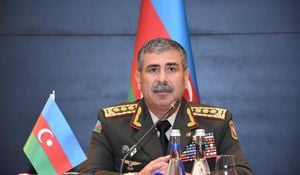International Mother Language Day, celebrated annually on February 21, is a global initiative dedicated to the promotion of linguistic and cultural diversity, recognizing the importance of mother languages as tools of communication, cultural identity, and heritage. This year marks the 25th anniversary of this observance established by UNESCO in 1999. The theme, "Languages Matter," resonates more strongly as advocates urge societies to embrace their native tongues.
The significance of International Mother Language Day cannot be understated; it serves as a reminder of the rich linguistic diversity present across the globe. Many languages are at risk of extinction due to globalization and urbanization, with experts indicating over 570 languages having already vanished. This decline also threatens cultural identities and intergenerational knowledge transfer.
Across the Caribbean, the relationship between language and identity is poignantly illustrated through Jamaican Patois. According to some advocates, celebrating and recognizing Jamaican Patois as more than just informal speech can bolster cultural pride. Patois reflects the island's blended history, incorporating elements from English, West African languages, Spanish, Portuguese, and more. Despite its prevalence, Patois often does not carry the same prestige as Standard Jamaican English, leading to calls for more recognition and acceptance of this vibrant language.
Reports highlight how Patois is deeply embedded within Jamaican music genres, especially reggae and dancehall. Artists such as Bob Marley have played pivotal roles in introducing the language to international audiences. Yet, the challenge remains for Jamaica to embrace its linguistic heritage fully. Educational changes, such as introducing bilingual programs combining Standard English and Patois, can help promote proficiency and pride among young Jamaicans.
Meanwhile, on the Indian subcontinent, the Nutan Marathi Higher Secondary School located in Paharganj, Delhi, champions the Marathi language. Established 96 years ago, this institution caters primarily to the Marathi-speaking population of Delhi, aiming to preserve the language against the backdrop of Hindi's predominance. Currently facing financial constraints, the school has sought government support to help maintain its legacy during the celebrations of the 98th Akhil Bharatiya Marathi Sahitya Sammelan being held in Delhi. With former chief minister Prithviraj Chavan among its alumni, the school embodies the aspirations of the Marathi community.
Vilas Kantute, general secretary of the Delhi Maharashtriya Educational and Cultural Society, pointed out, "The school was started for the children of the Marathi-speaking population settled in Delhi." The school has recently received assurance of support from Maharashtra's chief minister, Devendra Fadnavis, who expressed commitment to helping preserve the rich legacy of Marathi education.
A cross-continental perspective on preservation of native languages emerges from Ghana, where Madam Abla Dzifa Gomashie, the Minister of Tourism, Culture, and Creative Arts, took to Parliament to advocate for the use of indigenous languages as mediums of instruction at basic education levels. Her Resounding assertion points to the necessity of educational policy interventions to sustain linguistic diversity. "The use of indigenous languages is not only means of communication but also carry our collective history, traditions and cultural values," she stated emphatically during her address. Ghana nurtures over 80 indigenous languages, yet their usage is drastically declining, posing risks to preserving cultural heritage.
Gomashie's remarks amplified calls for logistical support aimed at teachers and educational institutions to incorporate mother languages meaningfully within curriculums. The efforts recognize languages as carriers of culture, emphasizing their significance beyond mere methods of communication. This aligns with the day’s objective of fostering appreciation for linguistic diversity worldwide.
The essence of International Mother Language Day is amplified through individual efforts spanning across communities and nations. This day not only draws attention to endangered languages but also encourages international solidarity among speakers of diverse languages around the world.
Reflecting on the significance of mother languages is more relevant now than ever, as communities must confront the realities of cultural homogenization and globalization. Celebrations of this day urge individuals to take active roles, whether by engaging with their mother tongues or supporting initiatives aimed at our endangered languages. Let's each do our part, fostering appreciation for the multifaceted layers embedded within our linguistic legacies.
International Mother Language Day is not just about acknowledging linguistic diversity; it’s about embedding respect for and recognition of every language within our global narrative. The voices of all languages deserve to be heard!



